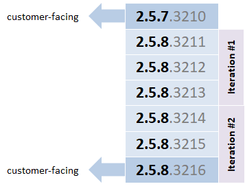Community resources
Community resources
How to manage JIRA releases: customer-facing vs iteration vs builds

I am trying to develop a better practice for managing and naming JIRA releases (versions) and associating JIRA issues with these. Here is the context:
- we use a 3-part version identifier in all customer-facing communication, e.g. 2.5.8 (2.5 being the major version, 8 being the service pack/maintenance release)
- the full version number in the software includes a 4th component, which is the build number and is set by the build server automatically. So there may be multiple builds 2.5.8.3211, 2.5.8.3212, etc. However, the customer would only ever see one of these - the last/approved one. Customers should not be faced with same version (3-parts) but different build (4th part)
- releases may be developed in multiple iterations (we do not use Scrum and sprints, but you may think of it this way)
Here is a diagram illustrating this:
I believe this is not that uncommon. Atlassian itself seems to be using 3-part version numbers as well and they are clearly developing these in multiple iterations.
Suppose the following cases:
- we want to do iterations planning and associate issues with iterations, i.e. issue 3,4,5 go into the first iteration of 2.5.8, issue 6,7,8 should be in the second iteration
- if a problem is discovered in 2.5.8 iteration #1, that did not exist in the previous customer-facing version (2.5.7) but needs to be fixed in iteration #2, this should be documented in a JIRA issue, but the issue is entirely of internal concern.
- we want to produce customer-facing release notes - basically a list of issues done since the last customer-facing release. The customer does not care if these were done in one or multiple iterations or builds.
My question is, how to organize this in JIRA.
If I create a JIRA release entry for each customer-facing version (i.e. 2.5.8), then I cannot associate issues with iterations or builds for internal use. I have issues with iteration planning (see case 1 above) and recoding issues that are relevant between iterations only (see case 2 above).
I am not sure how I could possibly create a JIRA release for each iteration, since the iteration does not end up in our version scheme. It could be made up (e.g. 2.5.8#1, 2.5.8#2) of course. However, this would render JIRA's release notes obsolete, as customers would not want to see release notes for an iteration, but cummulated for all iterations of a customer-facing version and they would not want to see "internal" issues that existed only between iterations.
I most likely do not want to create a JIRA release for each build.
Are there any best-practices how to do this? What methods are others applying?
I would love to hear your feedback and shared experience.
Recommended Learning For You
Level up your skills with Atlassian learning
Learning Path
Jira Administrator
Configure Jira Software, Jira Core, or Jira Service Management, including global settings, permissions, and schemes.
Managing Jira Projects Cloud
Learn to create and configure company-managed projects in Jira Software and partner effectively with Jira Admins.
Managing Permissions in Jira Cloud
Sharpen your skills at configuring and troubleshooting permissions in Jira Cloud with this free course.
Was this helpful?
Thanks!
- FAQ
- Community Guidelines
- About
- Privacy policy
- Notice at Collection
- Terms of use
- © 2024 Atlassian





